A Residual Middle Triassic Oceanic Island-Seamount in the Maoershan Area, Northwest Tibet: Implications for the Evolution of the Paleo-Tethys Ocean
Abstract
:1. Introduction
2. Geological Setting
2.1. Longmuco-Shuanghu Metamorphic Complex
2.2. Maoershan Complex
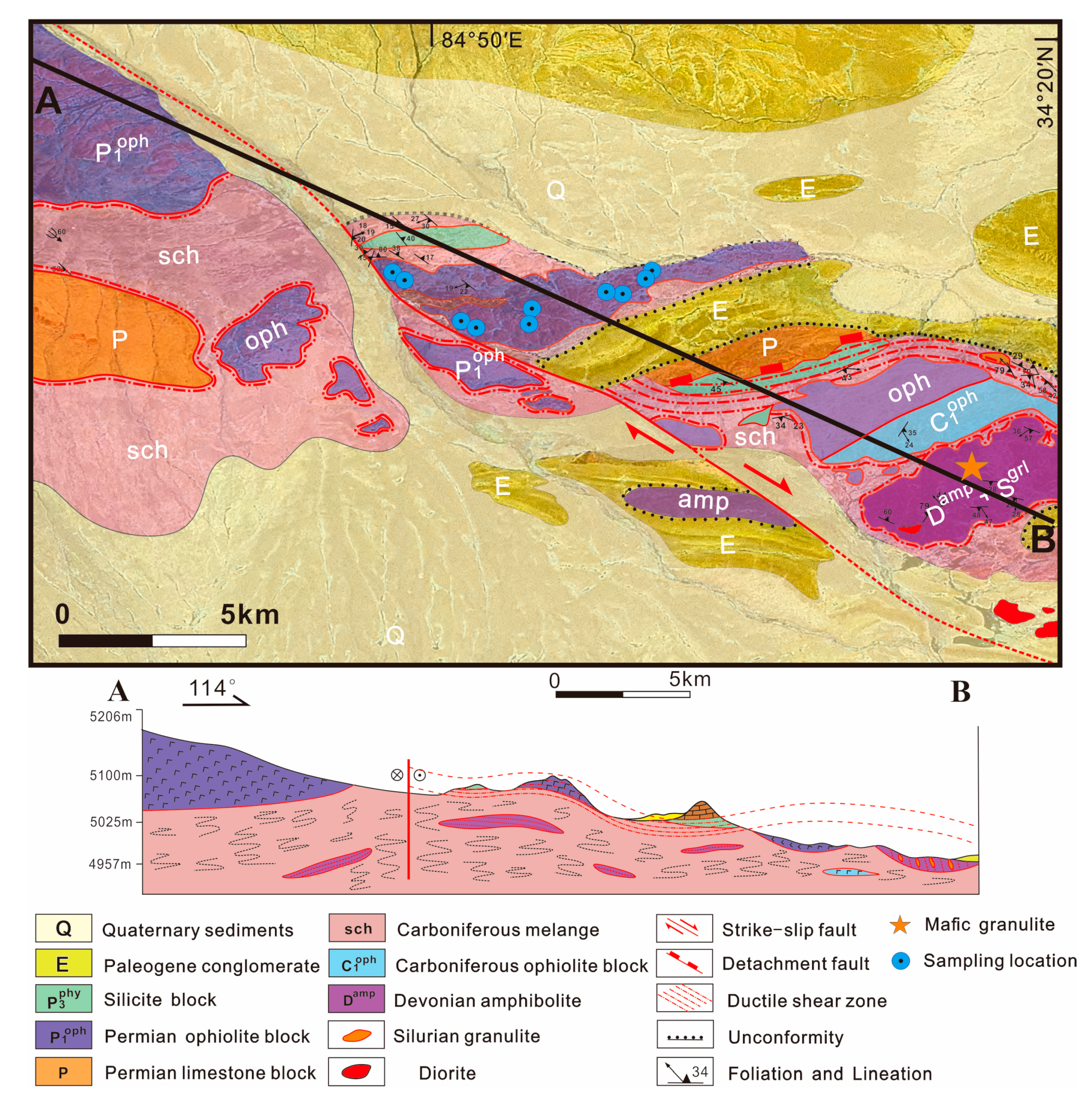
3. Field and Petrographic Observations

4. Analysis Methods
4.1. In Situ Zircon U-Pb Geochronology
4.2. Whole-Rock Major and Trace Elements
4.3. Whole-Rock Sr-Nd Isotopes
5. Results
5.1. Zircon U-Pb Geochronology
5.2. Whole-Rock Major and Trace Elements
5.2.1. Mafic Rocks
5.2.2. Cherts
5.3. Whole-Rock Sr-Nd Isotopes
6. Discussion
6.1. Age of Maoershan Oceanic Island-Seamount
6.2. Petrogenesis of Maoershan OIB-like mafic rocks
6.2.1. Crustal Contamination
6.2.2. Magma Source
6.2.3. Fractional Crystallization
6.3. Tectonic Environment
6.3.1. Mafic Rocks
6.3.2. Cherts
6.4. An Ocean Island-Seamount Chain of ~240 Ma in the West Segment of the Longmuco-Shuanghu Paleo-Tethys Ocean
6.5. Significance in the Evolution of the Longmuco-Shuanghu Paleo-Tethys Ocean
6.5.1. Closure Timing of the Longmuco-Shuanghu Paleo-Tethys Ocean
6.5.2. The Evolution Process of the Longmuco-Shuanghu Paleo-Tethys Ocean during the Permian–Triassic Period
7. Conclusions
Supplementary Materials
Author Contributions
Funding
Data Availability Statement
Acknowledgments
Conflicts of Interest
References
- Kennedy, D. 125. Science 2005, 309, 19. [Google Scholar] [CrossRef]
- Maruyama, S.; Ikoma, M.; Genda, H.; Hirose, K.; Yokoyama, T.; Santosh, M. The naked planet Earth: Most essential pre-requisite for the origin and evolution of life. Geosci. Front. 2013, 4, 141–165. [Google Scholar] [CrossRef]
- Zhu, R.; Hou, Z.; Guo, Z.; Wan, B. Summary of “the past, present and future of the habitable Earth: Development strategy of Earth science”. Chin. Sci. Bull. 2021, 66, 4485–4490. [Google Scholar] [CrossRef]
- Wu, L.; Jing, Z.; Chen, X.; Li, C.; Zhang, G.; Wang, S.; Dong, B.; Zhuang, G. Marine science in China: Current status and future outlooks. Earth Sci. Front. 2022, 29, 1–12. [Google Scholar]
- Niu, Y. Lithosphere thickness controls the extent of mantle melting, depth of melt extraction and basalt compositions in all tectonic settings on Earth—A review and new perspectives. Earth-Sci. Rev. 2021, 217, 103614. [Google Scholar] [CrossRef]
- Gao, X.; Li, J.C.; Yuan, G.L.; Wang, G.H.; Liang, X.; Zheng, Y.L.; Wang, Q. Middle-Late Triassic magmatic records for the accretionary processes of South Qiangtang accretionary terrane: The mafic dykes in Mayigangri-Jiaomuri area North Tibet. Acta Petrol. Sin. 2019, 35, 760–774. [Google Scholar] [CrossRef]
- Safonova, I.; Maruyama, S.; Kojima, S.; Komiya, T.; Krivonogov, S.; Koshida, K. Recognizing OIB and MORB in accretionary complexes: A new approach based on ocean plate stratigraphy, petrology and geochemistry. Gondwana Res. 2016, 33, 92–114. [Google Scholar] [CrossRef]
- Pullen, A.; Kapp, P.; Gehrels, G.E.; Ding, L.; Zhang, Q. Metamorphic rocks in central Tibet: Lateral variations and implications for crustal structure. Geol. Soc. Am. Bull. 2011, 123, 585–600. [Google Scholar] [CrossRef]
- Pullen, A.; Kapp, P.; Gehrels, G.E.; Vervoort, J.D.; Ding, L. Triassic continental subduction in central Tibet and Mediterranean-style closure of the Paleo-Tethys Ocean. Geology 2008, 36, 351–354. [Google Scholar] [CrossRef]
- Kapp, P.; Yin, A.; Manning, C.E.; Harrison, T.M.; Taylor, M.H.; Ding, L. Tectonic evolution of the early Mesozoic blueschist-bearing Qiangtang metamorphic belt, central Tibet. Tectonics 2003, 22, 1043. [Google Scholar] [CrossRef]
- Zhang, K.-J.; Zhang, Y.-X.; Li, B.; Zhu, Y.-T.; Wei, R.-Z. The blueschist-bearing Qiangtang metamorphic belt (northern Tibet, China) as an in situ suture zone: Evidence from geochemical comparison with the Jinsa suture. Geology 2006, 34, 493–496. [Google Scholar] [CrossRef]
- Zhao, Z.; Bons, P.D.; Wang, G.; Soesoo, A.; Liu, Y. Tectonic evolution and high-pressure rock exhumation in the Qiangtang terrane, central Tibet. Solid Earth 2015, 6, 457–473. [Google Scholar] [CrossRef]
- Li, D.; Wang, G.H.; Bons, P.D.; Zhao, Z.B.; Du, J.X.; Wang, S.L.; Yuan, G.L.; Liang, X.; Zhang, L.; Li, C.; et al. Subduction Reversal in a Divergent Double Subduction Zone Drives the Exhumation of Southern Qiangtang Blueschist-Bearing Mélange, Central Tibet. Tectonics 2019, 39, e2019TC006051. [Google Scholar] [CrossRef]
- Li, C. Twenty years of research on the Longmucu-Shuanghu-Lancangjiang suture zone in the Qinghai-Tibetan Plateau. Geol. Rev. 2008, 54, 105–119. [Google Scholar]
- Zhai, Q.-G.; Jahn, B.-M.; Zhang, R.-Y.; Wang, J.; Su, L. Triassic Subduction of the Paleo-Tethys in northern Tibet, China: Evidence from the geochemical and isotopic characteristics of eclogites and blueschists of the Qiangtang Block. J. Asian Earth Sci. 2011, 42, 1356–1370. [Google Scholar] [CrossRef]
- Zhai, Q.G.; Zhang, R.Y.; Jahn, B.M.; Li, C.; Song, S.G.; Wang, J. Triassic eclogites from central Qiangtang, northern Tibet, China: Petrology, geochronology and metamorphic PT path. Lithos 2011, 125, 173–189. [Google Scholar] [CrossRef]
- Zhang, X.-Z.; Dong, Y.-S.; Li, C.; Deng, M.-R.; Zhang, L.; Xu, W. Silurian high-pressure granulites from Central Qiangtang, Tibet: Constraints on early Paleozoic collision along the northeastern margin of Gondwana. Earth Planet. Sci. Lett. 2014, 405, 39–51. [Google Scholar] [CrossRef]
- Zhang, X.-Z.; Dong, Y.-S.; Wang, Q.; Dan, W.; Zhang, C.; Deng, M.-R.; Xu, W.; Xia, X.-P.; Zeng, J.-P.; Liang, H. Carboniferous and Permian evolutionary records for the Paleo-Tethys Ocean constrained by newly discovered Xiangtaohu ophiolites from central Qiangtang, central Tibet. Tectonics 2016, 35, 1670–1686. [Google Scholar] [CrossRef]
- Liang, X.; Wang, G.; Yang, B.; Ran, H.; Zheng, Y.; Du, J.; Li, L. Stepwise exhumation of the Triassic Lanling high-pressure metamorphic belt in Central Qiangtang, Tibet: Insights from a coupled study of metamorphism, deformation, and geochronology. Tectonics 2017, 36, 652–670. [Google Scholar] [CrossRef]
- Xu, W.; Liu, F.; Dong, Y. Cambrian to Triassic geodynamic evolution of central Qiangtang, Tibet. Earth-Sci. Rev. 2020, 201, 103083. [Google Scholar] [CrossRef]
- Fan, J.-J.; Li, C.; Xie, C.-M.; Liu, Y.-M.; Xu, J.-X.; Chen, J.-W. Remnants of late Permian–Middle Triassic ocean islands in northern Tibet: Implications for the late-stage evolution of the Paleo-Tethys Ocean. Gondwana Res. 2017, 44, 7–21. [Google Scholar] [CrossRef]
- Liu, D.; Shi, R.; Ding, L.; Jiang, S.-Y. Survived Seamount Reveals an in situ Origin for the Central Qiangtang Metamorphic Belt in the Tibetan Plateau. J. Earth Sci. 2019, 30, 1253–1265. [Google Scholar] [CrossRef]
- Kapp, P.; DeCelles, P.G. Mesozoic–Cenozoic geological evolution of the Himalayan-Tibetan orogen and working tectonic hypotheses. Am. J. Sci. 2019, 319, 159–254. [Google Scholar] [CrossRef]
- Zhai, Q.-G.; Jahn, B.-M.; Li, X.-H.; Zhang, R.-Y.; Li, Q.-L.; Yang, Y.-N.; Wang, J.; Liu, T.; Hu, P.-Y.; Tang, S.-H. Zircon U–Pb dating of eclogite from the Qiangtang terrane, north-central Tibet: A case of metamorphic zircon with magmatic geochemical features. Int. J. Earth Sci. 2016, 106, 1239–1255. [Google Scholar] [CrossRef]
- Zhang, X.Z.; Dong, Y.S.; Wang, Q.; Dan, W. High pressure metamorphic belt in central Qiangtang, Tibetan Plateau: Progress and unsolved problems. Geol. Bull. China 2018, 37, 1406–1416. [Google Scholar]
- Dan, W.; Wang, Q.; White, W.M.; Zhang, X.-Z.; Tang, G.-J.; Jiang, Z.-Q.; Hao, L.-L.; Ou, Q. Rapid formation of eclogites during a nearly closed ocean: Revisiting the Pianshishan eclogite in Qiangtang, central Tibetan Plateau. Chem. Geol. 2018, 477, 112–122. [Google Scholar] [CrossRef]
- Deng, X.; Ding, L.; Liu, X.; YIN, A.; KAPP, P.A.; Murphy, M.A.; Manning, C.E. Geochemical characteristics of the blueschists and its tectonic significance in the central Qiangtang area, Tibet. Acta Petrol. Sin. 2002, 18, 517–525. [Google Scholar]
- Zhang, X.; Dong, Y.; Li, C.; Shi, J.; Wang, S. Geochemistry and tectonic significance of eclogites in central Qiangtang, Tibetan Plateau. Geol. Bull. China 2010, 29, 1804–1814. [Google Scholar]
- Zhang, X.; Dong, Y.; Li, C.; Xie, C.; Wang, M.; Deng, M.; Zhang, L. A record of complex histories from oceanic lithosphere subduction to continental subduction and collision: Constraints on geochemistry of eclogite and blueschist in Central Qiangtang, Tibetan Plateau. Acta Petrol. Sin. 2014, 30, 2821–2834. [Google Scholar]
- Zhai, Q.-G.; Jahn, B.-M.; Wang, J.; Su, L.; Mo, X.-X.; Wang, K.-L.; Tang, S.-H.; Lee, H.-Y. The Carboniferous ophiolite in the middle of the Qiangtang terrane, Northern Tibet: SHRIMP U–Pb dating, geochemical and Sr–Nd–Hf isotopic characteristics. Lithos 2013, 168–169, 186–199. [Google Scholar] [CrossRef]
- Zhai, Q.-g.; Jahn, B.-m.; Wang, J.; Hu, P.-y.; Chung, S.-l.; Lee, H.-y.; Tang, S.-h.; Tang, Y. Oldest Paleo-Tethyan ophiolitic mélange in the Tibetan Plateau. Geol. Soc. Am. Bull. 2015, 128, 355–373. [Google Scholar] [CrossRef]
- Wu, Y.-W.; Li, C.; Xu, M.-J.; Xie, C.-M.; Wang, M.; Xiong, S.-Q.; Fan, Z.-G. Petrology, geochemistry, and geochronology of mafic rocks from the Taoxinghu Devonian ophiolite, LongmuCo–Shuanghu–Lancang suture zone, northern Tibet: Evidence for an intra-oceanic arc–basin system. Int. Geol. Rev. 2016, 58, 441–454. [Google Scholar] [CrossRef]
- Li, D.; Wang, G.-H.; Gao, J.; Yuan, G.; Zhou, J.; Fang, D.; Zhang, L.; Gong, Y.; Zhao, H. The continental subduction in the evolution of central qiangtang mélange belt and its tectonic significance. Int. Geol. Rev. 2018, 61, 1143–1170. [Google Scholar] [CrossRef]
- Liang, X.; Wang, G.; Yuan, G.; Liu, Y. Structural sequence and geochronology of the Qomo Ri accretionary complex, Central Qiangtang, Tibet: Implications for the Late Triassic subduction of the Paleo-Tethys Ocean. Gondwana Res. 2012, 22, 470–481. [Google Scholar] [CrossRef]
- Wang, G.; Li, D.; Liang, X.; Tang, Y. Determination of the double-layer structure in orogenic belts and its geological significance. J. Geomech. 2022, 28, 705–727. [Google Scholar]
- Lou, H.; Dong, Y.; Zhang, X.; Deng, M.; Zhang, L.; Xu, W. Disintegration of Early Devonian Maoershan Formation and delineation of ophiolite mélange in Xiangtaohu area of central Qiangtang, south Tibet. Geol. Bull. China 2014, 33, 1391–1399. [Google Scholar]
- Deng, M.; Dong, Y.; Zhang, X.; Zhang, L.; Xu, W.; Liu, J. Geochemical characteristics and tectonic implications of Hongjishan ophiolite in central and western part of Qiangtang, northern Tibetan Plateau. Geol. Bull. China 2014, 33, 1740–1749. [Google Scholar]
- Peng, Z.; Geng, Q.; Pan, G.; Wang, L.; Zhang, Z.; Cong, F.; Guan, J. Zircon SHRIMP geochronology and Nd-Pb isotopic characteristics of the meta-basalt in the central part of Tibetan Plateau’s Qiangtang region. Sci. China Earth Sci. 2014, 57, 428–438. [Google Scholar] [CrossRef]
- Black, L.P.; Kamo, S.L.; Allen, C.M.; Aleinikoff, J.N.; Davis, D.W.; Korsch, R.J.; Foudoulis, C. TEMORA 1: A new zircon standard for Phanerozoic U-Pb geochronology. Chem. Geol. 2003, 200, 155–170. [Google Scholar] [CrossRef]
- Wiedenbeck, M.; AllÉ, P.; Corfu, F.; Griffin, W.L.; Meier, M.; Oberli, F.; Quadt, A.V.; Roddick, J.C.; Spiegel, W. Three Natural Zircon Standards for U-Th-Pb, Lu-Hf, Trace Element and Ree Analyses. Geostand. Geoanal. Res. 1995, 19, 1–23. [Google Scholar] [CrossRef]
- Sláma, J.; Košler, J.; Condon, D.J.; Crowley, J.L.; Gerdes, A.; Hanchar, J.M.; Horstwood, M.S.A.; Morris, G.A.; Nasdala, L.; Norberg, N.; et al. Plešovice zircon—A new natural reference material for U–Pb and Hf isotopic microanalysis. Chem. Geol. 2008, 249, 1–35. [Google Scholar] [CrossRef]
- Liu, Y.; Gao, S.; Hu, Z.; Gao, C.; Zong, K.; Wang, D. Continental and Oceanic Crust Recycling-induced Melt–Peridotite Interactions in the Trans-North China Orogen: U–Pb Dating, Hf Isotopes and Trace Elements in Zircons from Mantle Xenoliths. J. Petrol. 2010, 51, 537–571. [Google Scholar] [CrossRef]
- Ludwig, K.R. ISOPLOT 3.0: A Geochronological Toolkit for Microsoft Excel; Berkeley Geochronology Center Special Publication: Berkeley, CA, USA, 2003; Volume 39, pp. 91–445. [Google Scholar]
- Andersen, T. Correction of common lead in U–Pb analyses that do not report 204Pb. Chem. Geol. 2002, 192, 59–79. [Google Scholar] [CrossRef]
- Sun, P.; Niu, Y.; Guo, P.; Chen, S.; Duan, M.; Gong, H.; Wang, X.; Xiao, Y. Multiple mantle metasomatism beneath the Leizhou Peninsula, South China: Evidence from elemental and Sr-Nd-Pb-Hf isotope geochemistry of the late Cenozoic volcanic rocks. Int. Geol. Rev. 2018, 61, 1768–1785. [Google Scholar] [CrossRef]
- Hoskin, P.; Black, L. Metamorphic zircon formation by solid-state recrystallization of protolith igneous zircon. J. Metamorph. Geol. 2000, 18, 423–439. [Google Scholar] [CrossRef]
- Escuder-Viruete, J.; Pérez-Estaún, A.; Weis, D.; Friedman, R. Geochemical characteristics of the Río Verde Complex, Central Hispaniola: Implications for the paleotectonic reconstruction of the Lower Cretaceous Caribbean island-arc. Lithos 2010, 114, 168–185. [Google Scholar] [CrossRef]
- Winchester, J.A.; Floyd, P.A. Geochemical discrimination of different magma series and their differentiation products using immobile elements. Chem. Geol. 1977, 20, 325–343. [Google Scholar] [CrossRef]
- Pearce, J. Role of the sub-continental lithosphere in magma genesis at active continental margin. In Continental Basalts and Mantle Xenoliths; Hawkesworth, C.J., Norry, M.J., Eds.; Shiva Publications: Nantwich, UK, 1983; pp. 230–249. [Google Scholar]
- Komiya, T.; Maruyama, S.; Hirata, T.; Yurimoto, H. Petrology and Geochemistry of MORB and OIB in the Mid-Archean North Pole Region, Pilbara Craton, Western Australia: Implications for the Composition and Temperature of the Upper Mantle at 3.5 Ga. Int. Geol. Rev. 2002, 44, 988–1016. [Google Scholar] [CrossRef]
- Sun, S.-S.; McDonough, W.F. Chemical and isotopic systematics of oceanic basalts: Implications for mantle composition and processes. Geol. Soc. Lond. Spec. Publ. 1989, 42, 313–345. [Google Scholar] [CrossRef]
- Pearce, J.A.; Cann, J.R. Tectonic setting of basic volcanic rocks determined using trace element analyses. Earth Planet. Sci. Lett. 1973, 19, 290–300. [Google Scholar] [CrossRef]
- Li, S. Ba-Nb-Th-La Diagrams Used to Identify Tectonic Environments of Ophiolite. Acta Petrol. Sin. 1993, 9, 146–157. [Google Scholar]
- Murray, R.W. Chemical criteria to identify the depositional environment of chert: General principles and applications. Sediment. Geol. 1994, 90, 213–232. [Google Scholar] [CrossRef]
- Haskin, L.A.; Haskin, M.A.; Frey, F.A.; Wildeman, T.R. Relative and Absolute Terrestrial Abundances of the Rare Earths. In Origin and Distribution of the Elements; Ahrens, L.H., Ed.; Pergamon: Oxford, UK, 1968; pp. 889–912. [Google Scholar]
- Verma, S.P. Seawater alteration effects on 87Sr86Sr, K, Rb, Cs, Ba and Sr in oceanic igneous rocks. Chem. Geol. 1981, 34, 81–89. [Google Scholar] [CrossRef]
- Xu, J.-F.; Castillo, P.R. Geochemical and Nd–Pb isotopic characteristics of the Tethyan asthenosphere: Implications for the origin of the Indian Ocean mantle domain. Tectonophysics 2004, 393, 9–27. [Google Scholar] [CrossRef]
- Liu, H.; Chen, Y.; Shang, Z. Zircon U-Pb Geochronology, Geochemistry and Geological Significance of the Santaishan–Yingjiang Ultramafic Rocks in Western Yunnan, China. Minerals 2023, 13, 536. [Google Scholar] [CrossRef]
- Porter, K.A.; White, W.M. Deep mantle subduction flux. Geochem. Geophys. Geosyst. 2009, 10, Q12016. [Google Scholar] [CrossRef]
- Bea, F.; Fershtater, G.B.; Montero, P.; Whitehouse, M.; Levin, V.Y.; Scarrow, J.H.; Austrheim, H.; Pushkariev, E.V. Recycling of continental crust into the mantle as revealed by Kytlym dunite zircons, Ural Mts, Russia. Terra Nova 2001, 13, 407–412. [Google Scholar] [CrossRef]
- Bea, F.; Montero, P.; Palma, J.F.M. Experimental evidence for the preservation of U-Pb isotope ratios in mantle-recycled crustal zircon grains. Sci. Rep. 2018, 8, 12904. [Google Scholar] [CrossRef]
- Skolotnev, S.G.; Bel’tenev, V.E.; Lepekhina, E.N.; Ipat’eva, I.S. Younger and older zircons from rocks of the oceanic lithosphere in the Central Atlantic and their geotectonic implications. Geotectonics 2010, 44, 462–492. [Google Scholar] [CrossRef]
- Torsvik, T.H.; Amundsen, H.; Hartz, E.H.; Corfu, F.; Kusznir, N.; Gaina, C.; Doubrovine, P.V.; Steinberger, B.; Ashwal, L.D.; Jamtveit, B. A Precambrian microcontinent in the Indian Ocean. Nat. Geosci. 2013, 6, 223–227. [Google Scholar] [CrossRef]
- Bea, F.; Bortnikov, N.; Montero, P.; Zinger, T.; Sharkov, E.; Silantyev, S.; Skolotnev, S.; Trukhalev, A.; Molina-Palma, J.F. Zircon xenocryst evidence for crustal recycling at the Mid-Atlantic Ridge. Lithos 2020, 354–355, 105361. [Google Scholar] [CrossRef]
- Condie, K.C. Chemical composition and evolution of the upper continental crust: Contrasting results from surface samples and shales. Chem. Geol. 1993, 104, 1–37. [Google Scholar] [CrossRef]
- Neal, C.R.; Mahoney, J.J.; Chazey, W.J., III. Mantle Sources and the Highly Variable Role of Continental Lithosphere in Basalt Petrogenesis of the Kerguelen Plateau and Broken Ridge LIP: Results from ODP Leg 183. J. Petrol. 2002, 43, 1177–1205. [Google Scholar] [CrossRef]
- Rudnick, R.L.; Gao, S. 3.01—Composition of the Continental Crust. In Treatise on Geochemistry; Holland, H.D., Turekian, K.K., Eds.; Pergamon: Oxford, UK, 2003; pp. 1–64. [Google Scholar]
- La Flèche, M.R.; Camiré, G.; Jenner, G.A. Geochemistry of post-Acadian, Carboniferous continental intraplate basalts from the Maritimes Basin, Magdalen Islands, Québec, Canada. Chem. Geol. 1998, 148, 115–136. [Google Scholar] [CrossRef]
- McCulloch, M.T.; Bennett, V.C. Progressive growth of the Earth’s continental crust and depleted mantle: Geochemical constraints. Geochim. Cosmochim. Acta 1994, 58, 4717–4738. [Google Scholar] [CrossRef]
- Niu, Y. Some basic concepts and problems on the petrogenesis of intra-plate ocean island basalts. Chin. Sci. Bull. 2009, 54, 4148–4160. [Google Scholar] [CrossRef]
- Reagan, M.K.; Gill, J.B. Coexisting calcalkaline and high-niobium basalts from Turrialba Volcano, Costa Rica: Implications for residual titanates in arc magma sources. J. Geophys. Res. Solid Earth 1989, 94, 4619–4633. [Google Scholar] [CrossRef]
- Xu, Y.; Chung, S.-L.; Jahn, B.-M.; Wu, G. Petrologic and geochemical constraints on the petrogenesis of Permian–Triassic Emeishan flood basalts in southwestern China. Lithos 2001, 58, 145–168. [Google Scholar] [CrossRef]
- Haase, K.M.; Stoffers, P.; Garbe-Schönberg, C.D. The Petrogenetic Evolution of Lavas from Easter Island and Neighbouring Seamounts, Near-ridge Hotspot Volcanoes in the SE Pacific. J. Petrol. 1997, 38, 785–813. [Google Scholar] [CrossRef]
- Haase, K.M.; Beier, C.; Kemner, F. A Comparison of the Magmatic Evolution of Pacific Intraplate Volcanoes: Constraints on Melting in Mantle Plumes. Front. Earth Sci. 2019, 6, 242. [Google Scholar] [CrossRef]
- Whitaker, M.L.; Nekvasil, H.; Lindsley, D.H.; Difrancesco, N.J. The Role of Pressure in Producing Compositional Diversity in Intraplate Basaltic Magmas. J. Petrol. 2007, 48, 365–393. [Google Scholar] [CrossRef]
- Niu, Y.; Wilson, M.; Humphreys, E.R.; O’hara, M.J. The origin of intra-plate ocean island basalts (OIB): The lid effect and its geodynamic implications. J. Petrol. 2011, 52, 1443–1468. [Google Scholar] [CrossRef]
- McKenzie, D.A.N.; O’Nions, R.K. Partial Melt Distributions from Inversion of Rare Earth Element Concentrations. J. Petrol. 1991, 32, 1021–1091. [Google Scholar] [CrossRef]
- Horn, I.; Foley, S.F.; Jackson, S.E.; Jenner, G.A. Experimentally determined partitioning of high field strength- and selected transition elements between spinel and basaltic melt. Chem. Geol. 1994, 117, 193–218. [Google Scholar] [CrossRef]
- Hart, S.R.; Dunn, T. Experimental cpx/melt partitioning of 24 trace elements. Contrib. Mineral. Petrol. 1993, 113, 1–8. [Google Scholar] [CrossRef]
- Hauri, E.H.; Wagner, T.P.; Grove, T.L. Experimental and natural partitioning of Th, U, Pb and other trace elements between garnet, clinopyroxene and basaltic melts. Chem. Geol. 1994, 117, 149–166. [Google Scholar] [CrossRef]
- Aldanmaz, E.; Pearce, J.A.; Thirlwall, M.F.; Mitchell, J.G. Petrogenetic evolution of late Cenozoic, post-collision volcanism in western Anatolia, Turkey. J. Volcanol. Geotherm. Res. 2000, 102, 67–95. [Google Scholar] [CrossRef]
- McKenzie, D.A.N.; O’Nions, R.K. The Source Regions of Ocean Island Basalts. J. Petrol. 1995, 36, 133–159. [Google Scholar] [CrossRef]
- Fitton, J.G.; Saunders, A.D.; Norry, M.J.; Hardarson, B.S.; Taylor, R.N. Thermal and chemical structure of the Iceland plume. Earth Planet. Sci. Lett. 1997, 153, 197–208. [Google Scholar] [CrossRef]
- Frey, F.A.; Green, D.H.; Roy, S.D. Integrated Models of Basalt Petrogenesis: A Study of Quartz Tholeiites to Olivine Melilitites from South Eastern Australia Utilizing Geochemical and Experimental Petrological Data. J. Petrol. 1978, 19, 463–513. [Google Scholar] [CrossRef]
- Hess, P.C. Phase equilibria constraints on the origin of ocean floor basalts. Wash. DC Am. Geophys. Union Geophys. Monogr. Ser. 1992, 71, 67–102. [Google Scholar] [CrossRef]
- Wilson, M. Igneous Petrogenesis: A Global Tectonic Approach; Unwin Hyman: London, UK, 1989. [Google Scholar]
- Jung, S.; Masberg, P. Major- and trace-element systematics and isotope geochemistry of Cenozoic mafic volcanic rocks from the Vogelsberg (central Germany). J. Volcanol. Geotherm. Res. 1998, 86, 151–177. [Google Scholar] [CrossRef]
- Humphreys, E.R.; Niu, Y. On the composition of ocean island basalts (OIB): The effects of lithospheric thickness variation and mantle metasomatism. Lithos 2009, 112, 118–136. [Google Scholar] [CrossRef]
- Kato, Y. Origin and global tectonic significance of Early Archean cherts from the Marble Bar greenstone belt, Pilbara Craton, Western Australia. Precambrian Res. 2003, 125, 191–243. [Google Scholar] [CrossRef]
- Murray, R.W.; Buchholtz ten Brink, M.R.; Jones, D.L.; Gerlach, D.C.; Russ, G.P., III. Rare earth elements as indicators of different marine depositional environments in chert and shale. Geology 1990, 18, 268–271. [Google Scholar] [CrossRef]
- Girty, G.H.; Ridge, D.L.; Knaack, C.; Johnson, D.; Al-Riyami, R.K. Provenance and depositional setting of Paleozoic chert and argillite, Sierra Nevada, California. J. Sediment. Res. 1996, 66, 107–118. [Google Scholar] [CrossRef]
- Malovitskiy, Y.P.; Emelyanov, E.M.; Kazakov, O.V.; Moskalenko, V.N.; Osipov, G.V.; Shimkus, K.M.; Chumakov, I.S. Geological structure of the Mediterranean Sea floor (based on geological—Geophysical data). Mar. Geol. 1975, 18, 231–261. [Google Scholar] [CrossRef]
- Dan, W.; Wang, Q.; White, W.M.; Li, X.-H.; Zhang, X.-Z.; Tang, G.-J.; Ou, Q.; Hao, L.-L.; Qi, Y. Passive-margin magmatism caused by enhanced slab-pull forces in central Tibet. Geology 2020, 49, 130–134. [Google Scholar] [CrossRef]
- Yang, T.N.; Zhang, H.R.; Liu, Y.X.; Wang, Z.L.; Song, Y.C.; Yang, Z.S.; Tian, S.H.; Xie, H.Q.; Hou, K.J. Permo-Triassic arc magmatism in central Tibet: Evidence from zircon U–Pb geochronology, Hf isotopes, rare earth elements, and bulk geochemistry. Chem. Geol. 2011, 284, 270–282. [Google Scholar] [CrossRef]
- Peng, T.; Zhao, G.; Fan, W.; Peng, B.; Mao, Y. Late Triassic granitic magmatism in the Eastern Qiangtang, Eastern Tibetan Plateau: Geochronology, petrogenesis and implications for the tectonic evolution of the Paleo-Tethys. Gondwana Res. 2015, 27, 1494–1508. [Google Scholar] [CrossRef]
- Zhang, K.-J.; Tang, X.-C.; Wang, Y.; Zhang, Y.-X. Geochronology, geochemistry, and Nd isotopes of early Mesozoic bimodal volcanism in northern Tibet, western China: Constraints on the exhumation of the central Qiangtang metamorphic belt. Lithos 2011, 121, 167–175. [Google Scholar] [CrossRef]
- Lu, L.; Qin, Y.; Li, Z.-F.; Yan, L.-L.; Jin, X.; Zhang, K.-J. Diachronous closure of the Shuanghu Paleo-Tethys Ocean: Constraints from the Late Triassic Tanggula arc-related volcanism in the East Qiangtang subterrane, Central Tibet. Lithos 2019, 328, 182–199. [Google Scholar] [CrossRef]
- Fan, J.-J.; Li, C.; Xie, C.-M.; Liu, Y.-M. Depositional environment and provenance of the upper Permian–Lower Triassic Tianquanshan Formation, northern Tibet: Implications for the Palaeozoic evolution of the Southern Qiangtang, Lhasa, and Himalayan terranes in the Tibetan Plateau. Int. Geol. Rev. 2016, 58, 228–245. [Google Scholar] [CrossRef]
- Li, C.; Zhai, Q.; Dong, Y.; Yu, J.; Huang, X. Estahlishment of the Unner Triassir Wanchulinn Eormation at Guoganjianian Mountain, central Qiangtang, Qinghai-Tibet Plateau, and its significance. Geol. Bull. China 2007, 26, 1003–1008. [Google Scholar]
- Jin, X.; Zhang, Y.-X.; Zhou, X.-Y.; Zhang, K.-J.; Li, Z.-W.; Khalid, S.B.; Hu, J.-C.; Lu, L.; Sun, W.-D. Protoliths and tectonic implications of the newly discovered Triassic Baqing eclogites, central Tibet: Evidence from geochemistry, Sr Nd isotopes and geochronology. Gondwana Res. 2019, 69, 144–162. [Google Scholar] [CrossRef]
- Wu, Y.; Li, C.; Xie, C.; Wang, M.; Hu, P. Petrology and geochronology of Guoganjianianshan Permian ophiolite in ceatral Qiangtang, Qinghai-Tibet Plateau, China. Geol. Bull. China 2010, 29, 1773–1780. [Google Scholar]
- Chen, Y.; Ye, K. Exhumation of subducted oceanic crust: Key issues and discussion. Acta Petrol. Sin. 2013, 29, 1461–1478. [Google Scholar]
- Tian, Y.; Liang, X.; Wang, G.; Tang, Y.; Chen, S.; Gao, X.; Yang, B.; Guo, Z.; Wang, Y.; Wen, J. Protolith origin of the Lanling high-pressure metamorphic terrane in central Qiangtang, Tibet, reveals the subduction of the Permian–Triassic ocean island and abyssal submarine fan in the Paleo-Tethys Ocean. Gondwana Res. 2023, 121, 404–417. [Google Scholar] [CrossRef]
- Ou, Q.; Wang, Q.; Zeng, J.-P.; Yang, J.-H.; Zhang, H.-X.; Xia, X.-P.; Chen, Y.-W. Petrogenesis and tectonic implications of Middle Triassic basalts and rhyolites in the northern Qiangtang Block, central Tibet. J. Asian Earth Sci. 2021, 206, 104573. [Google Scholar] [CrossRef]
- He, H.; Li, Y.; Wang, T.; Xiao, S.; Wang, Z.; Chen, L.; Feng, Z.; Han, S.; Liu, S.; Zhang, Y.; et al. Late Triassic granites (ca. 230 Ma) from Cairi area in eastern Qiangtang subterrane, central Tibet: Product of a mid-oceanic ridge subduction. Geol. J. 2022, 57, 150–165. [Google Scholar] [CrossRef]
- Wang, Q.; Wyman, D.A.; Xu, J.; Wan, Y.; Li, C.; Zi, F.; Jiang, Z.; Qiu, H.; Chu, Z.; Zhao, Z.; et al. Triassic Nb-enriched basalts, magnesian andesites, and adakites of the Qiangtang terrane (Central Tibet): Evidence for metasomatism by slab-derived melts in the mantle wedge. Contrib. Mineral. Petrol. 2007, 155, 473–490. [Google Scholar] [CrossRef]
- Zhang, H.; Yang, T.; Hou, Z.; Wang, Y. Magmatic expression of tectonic transition from oceanic subduction to continental collision: Insights from the Middle Triassic rhyolites of the North Qiangtang Block. Gondwana Res. 2020, 87, 67–82. [Google Scholar] [CrossRef]
- Wang, J.; Fu, X.; Wei, H.; Shen, L.; Wang, Z.; Li, K. Late Triassic basin inversion of the Qiangtang Basin in northern Tibet: Implications for the closure of the Paleo-Tethys and expansion of the Neo-Tethys. J. Asian Earth Sci. 2022, 227, 105119. [Google Scholar] [CrossRef]
- Fu, X.; Wang, J.; Tan, F.; Chen, M.; Chen, W. The Late Triassic rift-related volcanic rocks from eastern Qiangtang, northern Tibet (China): Age and tectonic implications. Gondwana Res. 2010, 17, 135–144. [Google Scholar] [CrossRef]
- Li, J.; Zhao, Z.; Zheng, Y.; Yuan, G.; Liang, X.; Wang, G.; Liu, X. The magmatite evidences in southern Qiangtang for paleo-Tethys ocean subducting collision: Gangtang-co granites in Rongma, Tibet. Acta Petrol. Sin. 2015, 31, 2078–2088. [Google Scholar]
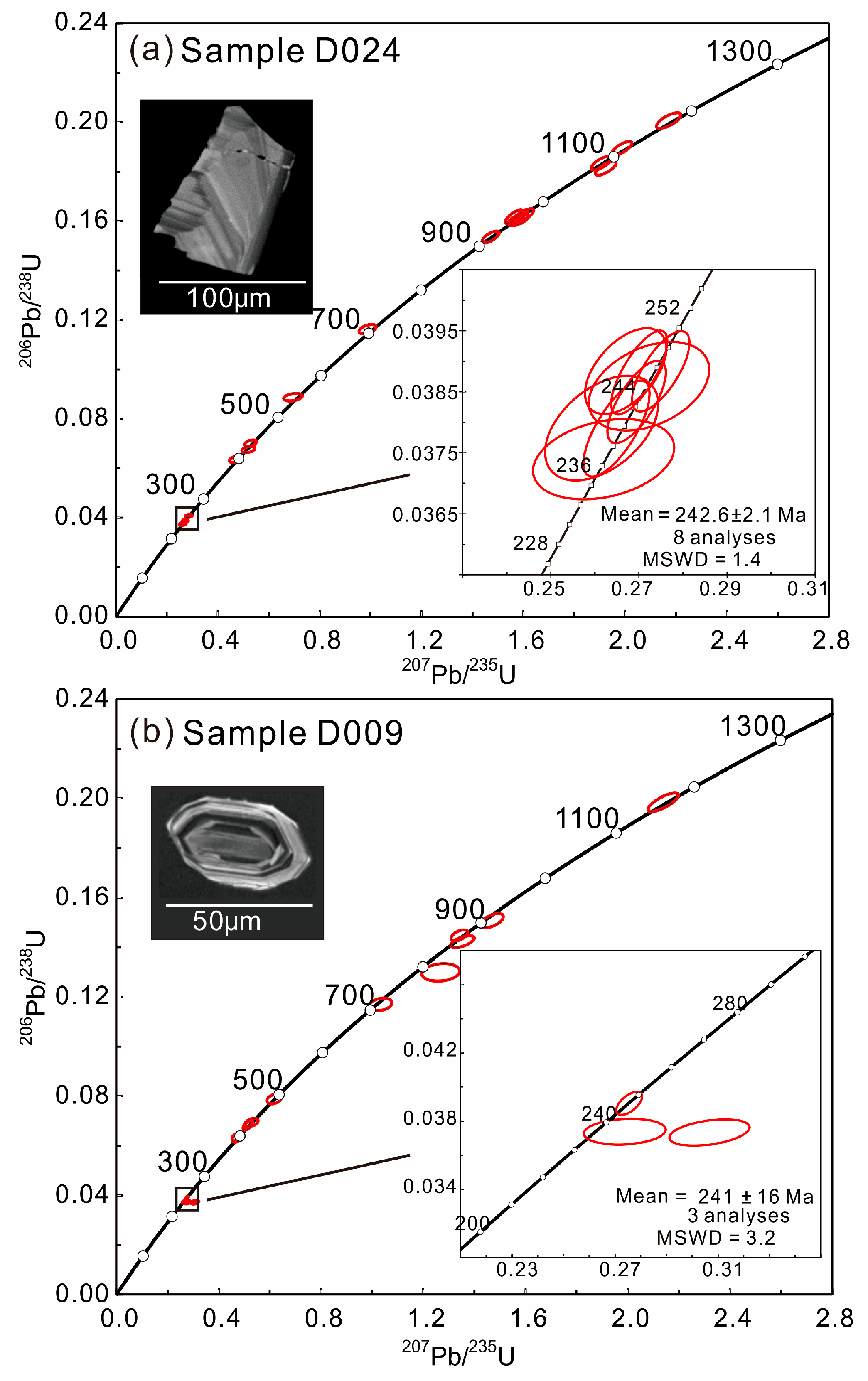



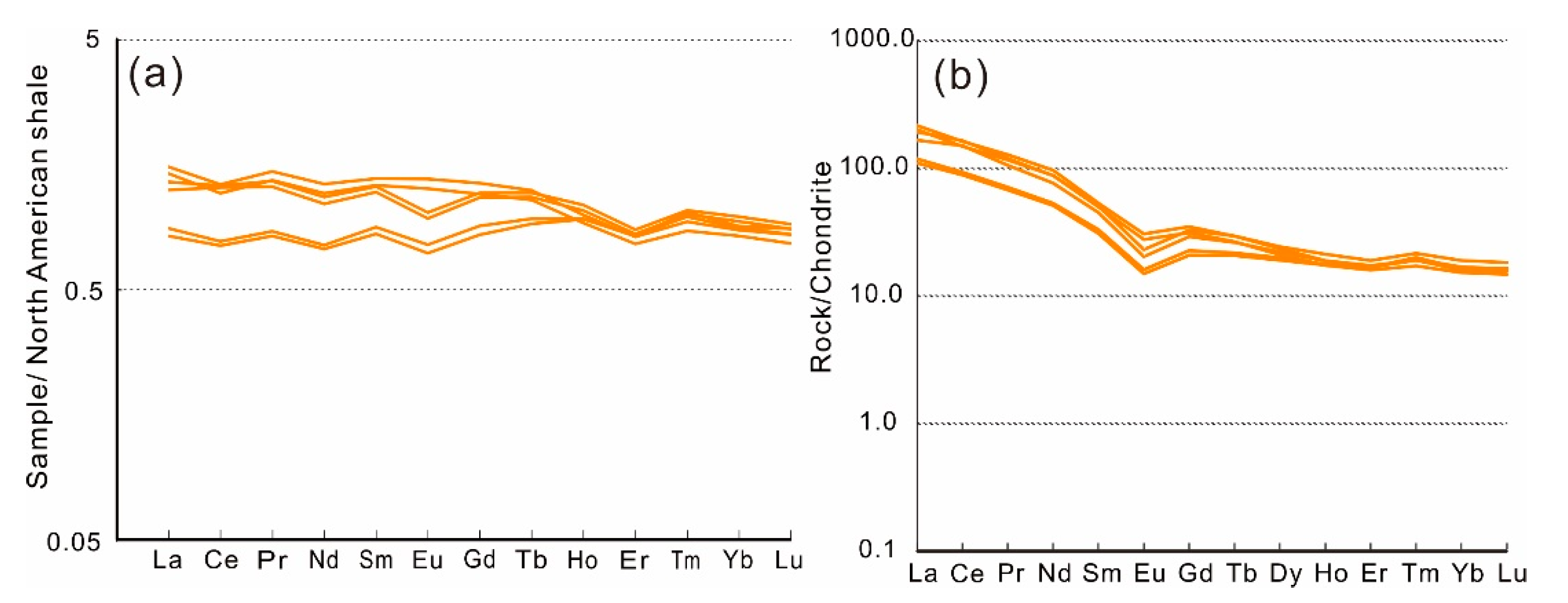

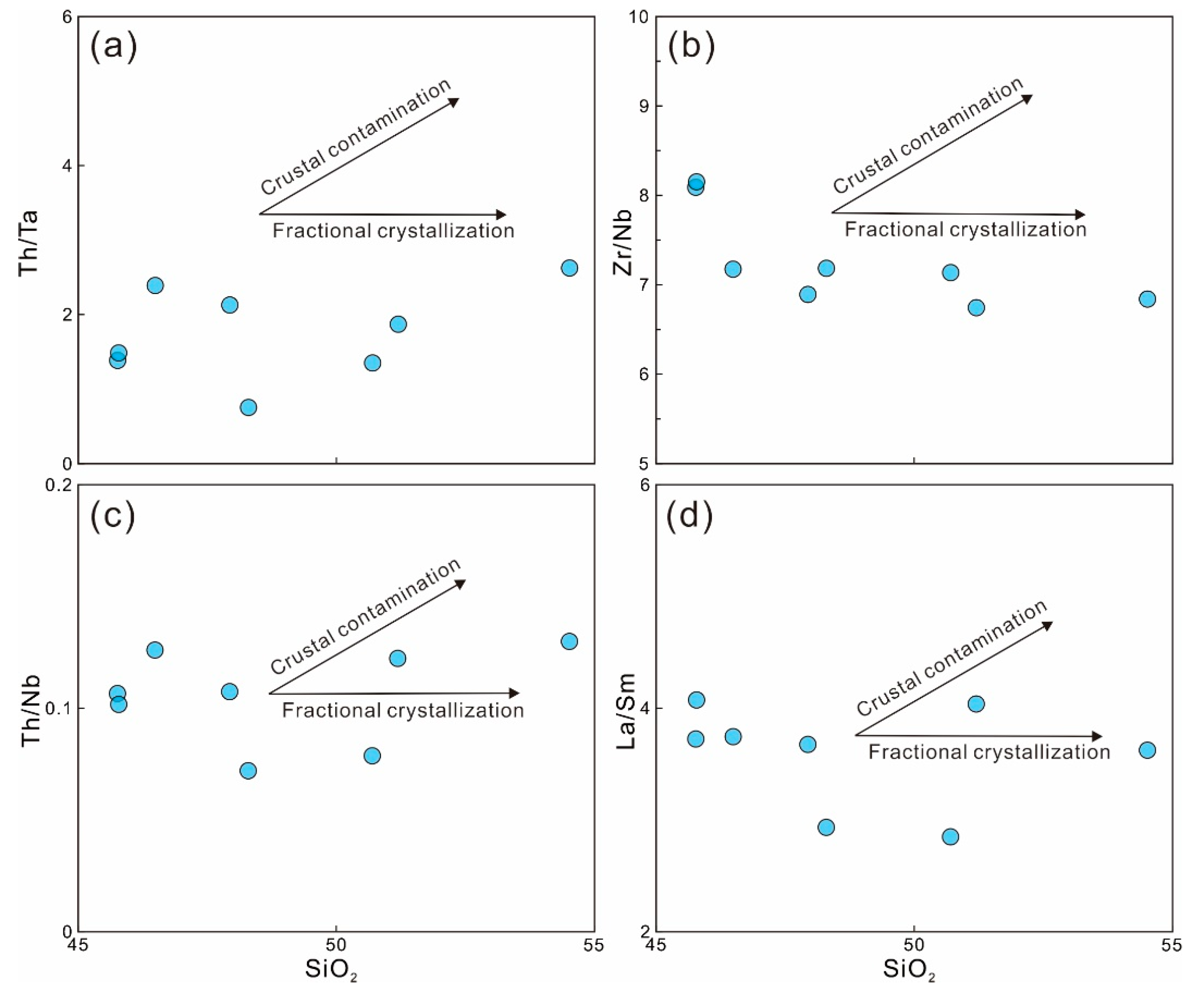


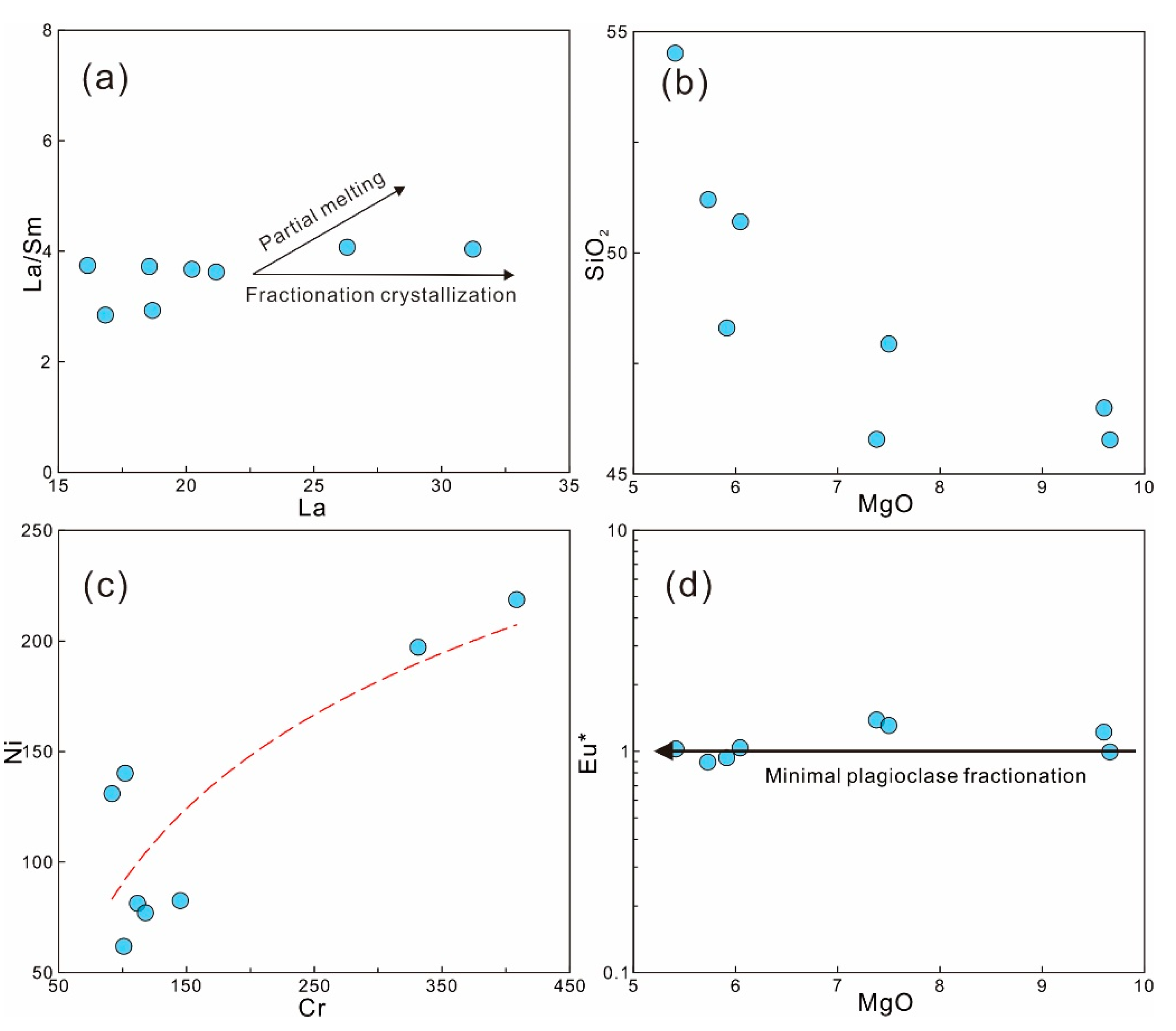
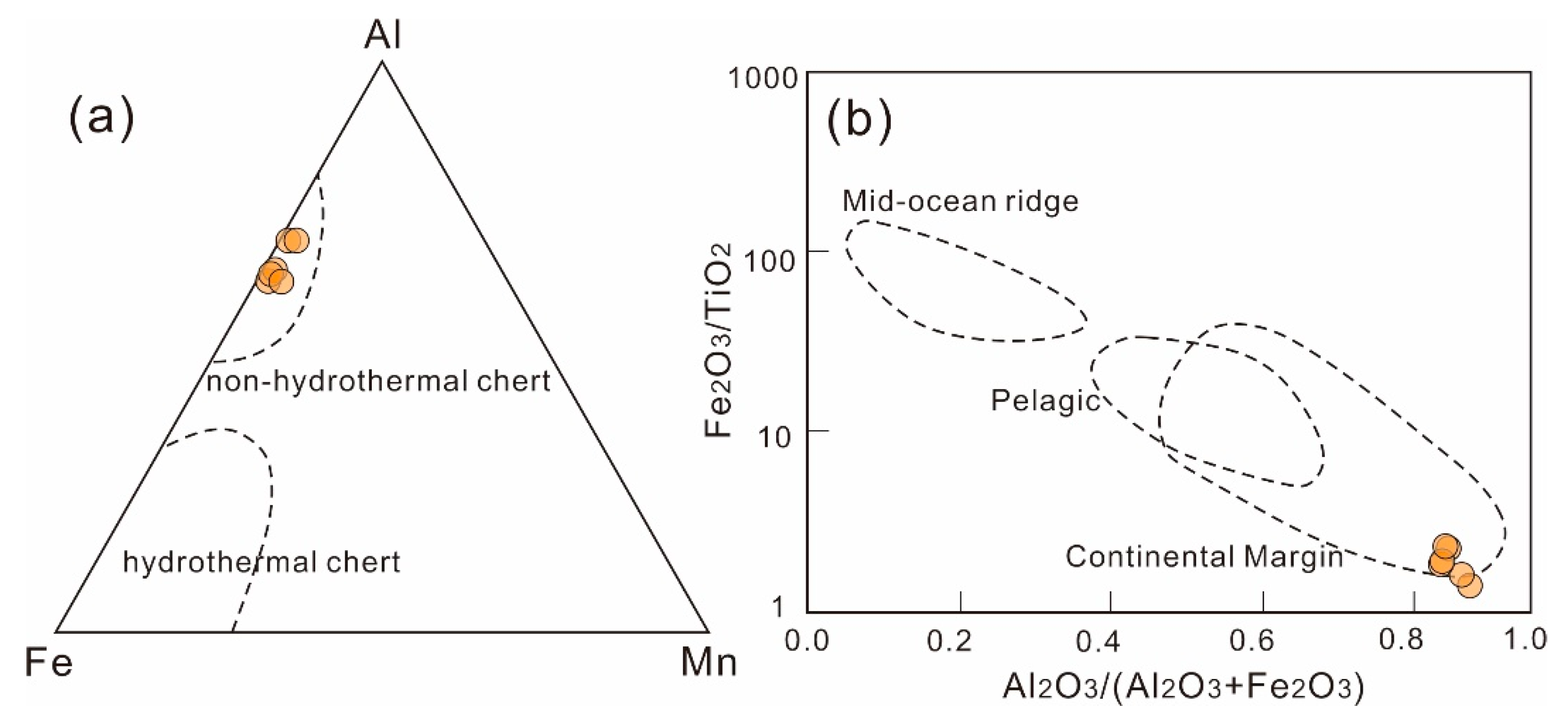
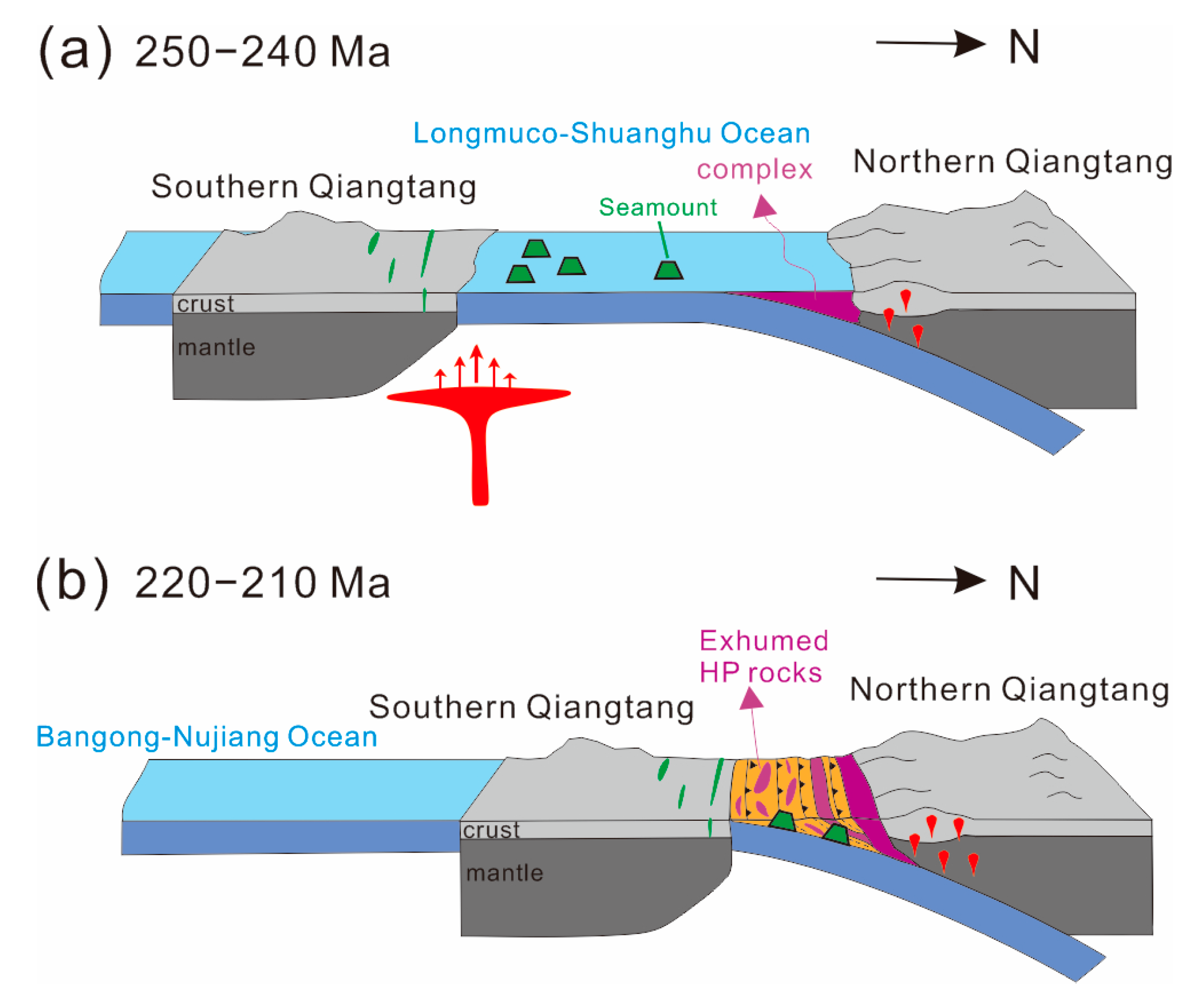
Disclaimer/Publisher’s Note: The statements, opinions and data contained in all publications are solely those of the individual author(s) and contributor(s) and not of MDPI and/or the editor(s). MDPI and/or the editor(s) disclaim responsibility for any injury to people or property resulting from any ideas, methods, instructions or products referred to in the content. |
© 2023 by the authors. Licensee MDPI, Basel, Switzerland. This article is an open access article distributed under the terms and conditions of the Creative Commons Attribution (CC BY) license (https://creativecommons.org/licenses/by/4.0/).
Share and Cite
Li, C.; Wen, J.; Zhao, Z.; Yang, F.; Yan, J.; Tian, Y.; Su, R. A Residual Middle Triassic Oceanic Island-Seamount in the Maoershan Area, Northwest Tibet: Implications for the Evolution of the Paleo-Tethys Ocean. Minerals 2023, 13, 1551. https://doi.org/10.3390/min13121551
Li C, Wen J, Zhao Z, Yang F, Yan J, Tian Y, Su R. A Residual Middle Triassic Oceanic Island-Seamount in the Maoershan Area, Northwest Tibet: Implications for the Evolution of the Paleo-Tethys Ocean. Minerals. 2023; 13(12):1551. https://doi.org/10.3390/min13121551
Chicago/Turabian StyleLi, Chao, Junhao Wen, Zhongbao Zhao, Feng Yang, Jiaxin Yan, Ye Tian, and Rong Su. 2023. "A Residual Middle Triassic Oceanic Island-Seamount in the Maoershan Area, Northwest Tibet: Implications for the Evolution of the Paleo-Tethys Ocean" Minerals 13, no. 12: 1551. https://doi.org/10.3390/min13121551






